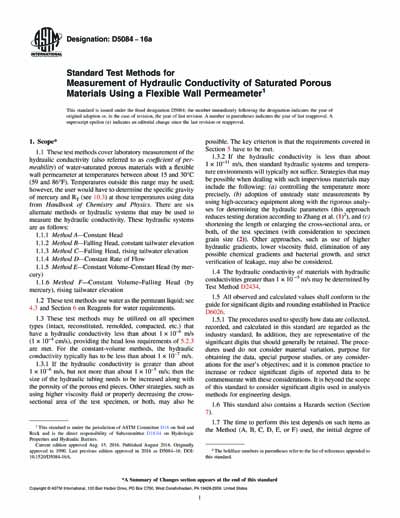Most recent
ASTM D5084-16a
Standard Test Methods for Measurement of Hydraulic Conductivity of Saturated Porous Materials Using a Flexible Wall Permeameter
1.1 These test methods cover laboratory measurement of the hydraulic conductivity (also referred to as coefficient of permeability) of water-saturated porous materials with a flexible wall permeameter at temperatures between about 15 and 30°C (59 and 86°F). Temperatures outside this range may be used; however, the user would have to determine the specific gravity of mercury and RT (see 10.3) at those temperatures using data from Handbook of Chemistry and Physics. There are six alternate methods or hydraulic systems that may be used to measure the hydraulic conductivity. These hydraulic systems are as follows:...
1.2 These test methods use water as the permeant liquid; see 4.3 and Section 6 on Reagents for water requirements.
1.3 These test methods may be utilized on all specimen types (intact, reconstituted, remolded, compacted, etc.) that have a hydraulic conductivity less than about 1 × 10−6 m/s (1 × 10−4 cm/s), providing the head loss requirements of 5.2.3 are met. For the constant-volume methods, the hydraulic conductivity typically has to be less than about 1 × 10−7 m/s.
1.4 The hydraulic conductivity of materials with hydraulic conductivities greater than 1 × 10 −5 m/s may be determined by Test Method D2434.
1.5 All observed and calculated values shall conform to the guide for significant digits and rounding established in Practice D6026.
1.5.1 The procedures used to specify how data are collected, recorded, and calculated in this standard are regarded as the industry standard. In addition, they are representative of the significant digits that should generally be retained. The procedures used do not consider material variation, purpose for obtaining the data, special purpose studies, or any considerations for the user's objectives; and it is common practice to increase or reduce significant digits of reported data to be commensurate with these considerations. It is beyond the scope of this standard to consider significant digits used in analysis methods for engineering design.
1.6 This standard also contains a Hazards section (Section 7).
1.7 The time to perform this test depends on such items as the Method (A, B, C, D, E, or F) used, the initial degree of saturation of the test specimen and the hydraulic conductivity of the test specimen. The constant volume Methods (E and F) and Method D require the shortest period-of-time. Typically a test can be performed using Methods D, E, or F within two to three days. Methods A, B, and C take a longer period-of-time, from a few days to a few weeks depending on the hydraulic conductivity. Typically, about one week is required for hydraulic conductivities on the order of 1 × 10–9 m/s. The testing time is ultimately controlled by meeting the equilibrium criteria for each Method (see 9.5).
1.8 Units—The values stated in SI units are to be regarded as the standard. The inch-pound units given in parentheses are mathematical conversions, which are provided for information purposes only and are not considered standard, unless specifically stated as standard, such as 0.5 mm or 0.01 in.
1.9 This standard does not purport to address all of the safety concerns, if any, associated with its use. It is the responsibility of the user of this standard to establish appropriate safety and health practices and determine the applicability of regulatory limitations prior to use.
ASTM International [astm]

